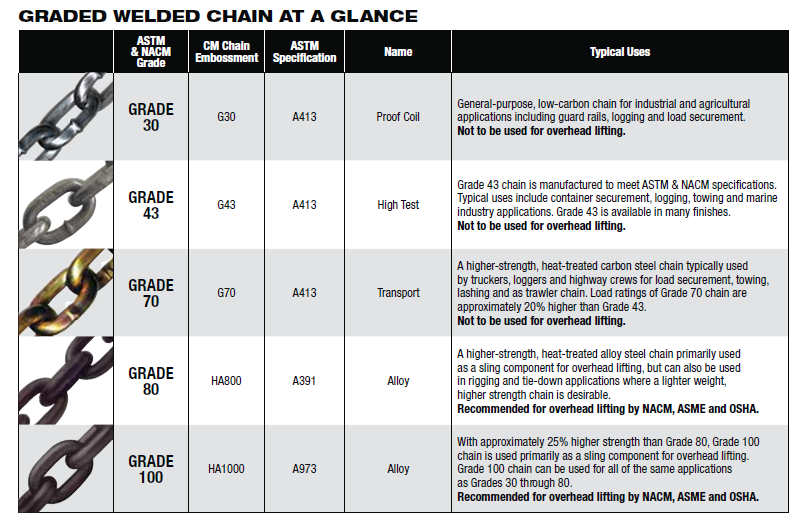Understanding the Difference between Chain Grades and How They’re Used
A Guide to Graded Welded Chain | 3 Minute Read
Transportation and Rail | Rigging | By Henry Brozyna | Feb 20, 2020
Chain has been around for over a thousand years. It is one of the most versatile and reliable ways to lift, tension and tie down materials in a variety of applications. In the past, people would use any type of chain to lift something, tie down a load or tow a vehicle. Proper inspection, safety procedures and general standards of practice for chain were lacking.
In recent years, due to safety concerns and regulations, the industry has begun to differentiate between various materials and grades of chain and the specific applications they should be used for. ASTM (American Society of Testing & Materials), ASME (American Society of Mechanical Engineers) and OSHA (Occupational Safety & Health Administration) began to publish safety standards and regulations for the manufacturing, testing, use, inspection and repair of chain.
Chain Grades
One of the safety measures implemented was to place chain in Grades based on the ultimate breaking strength of that chain. This number is what we see today G30, G43, G70, G80 & G100 and the common chain grades. The number after each letter is N/mm2. For example, G80 means that the maximum stress on the chain at ultimate strength is 800 newtons per millimeter squared.
Working Load Limit (WLL) of Chain
The other safety measure was identifying which types of chain are appropriate and strong enough for overhead lifting. Anytime we move or lift a load it is dangerous. Moving a load along the ground has the advantage that the ground is supporting the load. We have to overcome the coefficient of friction to move the load. The chain’s working load limit does not have to match the weight of the load. It needs to be able to handle the tension applied, which is based on the surface that it is being moved over plus some fraction of the weight of the load. This can be calculated using formulas.
If we lift that same load off the ground, we now have to overcome gravity. The chain’s working load limit will have to be of sufficient strength to support the weight of the load plus any additional forces imposed by angles and hitch type(s) used.
Which Chain Grade Should Be Used for Which Type of Application?
Alloy Chain Grade 80 or Grade 100 should be used for overhead lifting. ASTM states that alloy chain shall be able to elongate a minimum of 20% before fracture (7.3.5). To ensure that alloy chain consistently meets this requirement, ASTM requires the use of certain alloying elements in the manufacturing of the steel for alloy steel chain. These alloys can vary from company to company, but some key requirements are specified by ASTM. The alloy properties also improve the wear and tear that the chain will experience. Note that when chain is in use, no amount of stretch is allowed.
Carbon Grade 70 chain is a “heat treated” carbon steel chain that has no alloying elements added to the steel. This chain will elongate before breaking but does not have the properties needed for overhead lifting; therefore, Grade 70 chain is not intended for overhead lifting. This chain is designed for use as a tie down chain or lashing for transportation. Grade 70 chain has a gold chromate finish to help resist corrosion from continuous exposure to the elements and the rigors of highway use, such as road salts in the winter.
When any type of overhead lifting is required, use only alloy chain slings unless specified by the manufacturer.
The preferred chain for load securement is Grade 70, but any grade of chain can be used for tie downs or tensioning. You have to know your tensions in order to select the proper chain. Refer to load securement safety standards FMCSA (Federal Motor Carrier Safety Administration), CVSA (Commercial Vehicle Safety Alliance), WSTDA (Web Sling Tie down Association) or the state regulations for more information.
Download this Guide to have readily available at your worksite
Invest in Proper Training
Training is key in knowing how to properly size and use any type of chain for any application. View our upcoming schedule of courses.
Columbus McKinnon has a robust video library of training and product videos. Watch our Safety Webinar on Load Securement.
Henry Brozyna
Henry Brozyna is an Industry Product Trainer at Columbus McKinnon specializing in Crane and Hoist Inspection and Repair, Rigging & Load Securement He has been training on crane and rigging safety for more than 20 years. Henry is a member of the Tie Down committee and former Board of Directors for the WSTDA; this group writes the standards that are used by the material handling industry, the transportation industry, and also law enforcement. Henry is also a current member of the Crane Institute’s board of directors.

Related Products
WLL: 800 to 10,600 lbs.
Sizes: 3/16 to 3/4 in.



 North America - EN
North America - EN







